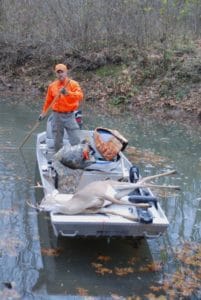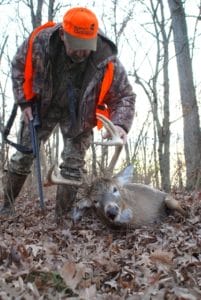by Bill Cooper
Thousands of miles of rivers and waterways course their way across America. Deer commonly utilize these corridors of life. Most rivers and surrounding lands provide all the essentials for a deer to survive: food, water and cover. Few hunters, however, utilize rivers to transport them into some of the finest and most remote deer hunting area available in the nation.

Jetboats are a popular means of accessing remote areas along many of the nation’s shallow, rocky rivers.
A new dimension
While there is nothing inherently wrong with hunting river bottoms that are accessed by land, floating or boating up or down a river to access remote areas to deer hunt adds a whole new dimension to deer hunting. I began using both canoes and boats to access remote areas in the Missouri Ozarks after decades of floating a half dozen rivers which took me through expanses of wild country. Sightings of abundant deer trails became the norm as I drifted downstream on any of my favorite rivers. The wilder the country, the more trails I discovered.
Utilize maps
Regardless of what region of the country you decide to choose for a river hunting expedition, purchase the best maps available of the river you intend to traverse. Most state fish, wildlife and park agencies now have detailed maps of riverways, which show boundary lines for both public and private lands.
Experienced deer hunters can look at a good map and pick numerous spots where deer hunting will be exceptional. Look for funnels such as tributary streams, islands, river bottoms, bluff lines, ravines and edges. Find as many of these features as you can on your maps before making your first scouting trip.
Maps are a hunting tool and should be used religiously. They will make your deer hunt both enjoyable and more productive. Begin your search for maps on Websites like: www.mytopo.com, www.terraserver.com, and www.usgs.gov. Purchase both a topographical map and an aerial photo and spend much time with them. And never begin a river hunting trip without them.
River terrain
Rivers run downhill. Therein lies both positives and negatives for deer hunters. For the canoeing deer hunter, the flow of the river provides a power source to move downstream. Maps and scouting trips will help unveil long, slow moving stretches where paddling will be in order. Such stretches can eat up both time and energy to paddle. Know where they are and how much time it will take to cover them.
Rivers are classified by difficulty, with a Class 1 rating being the easiest. Know the rating of the river system you intend to hunt. Make at least one trip on your chosen stream well before the hunt date. If you are inexperienced, hire a guide or make the trip with a heavily experienced individual.
Obstacles in a river such as boulders, logs, downed trees, sharp turns and drops are real hazards. Know where they exist and learn how to negotiate them.
Most rivers have river bottoms or sand or gravel bars, which are great places to pitch a camp. Pick spots that will not leave you stranded or trapped should the weather turn sour.
Larger river systems lend themselves to the use of boats, making travel both up and down river possible. This option adds a great deal more flexibility to a deer-hunting plan.
A popular choice on rocky, shallow rivers is a jetboat, which will run in very shallow water.
Where to hunt
The possibilities of areas to deer hunt along a river corridor can be mind-boggling. Scouting trips will reveal dozens of well-worn deer trails coming down river banks. Studying your maps and burning some shoe leather on the ground will narrow your choices.

Backtracking a deer trail from a river crossing can lead to the juncture of numerous trails coming together. Such areas are hotspots.
Rivers often serve as a dividing line between bedding areas, feeding areas and loafing areas. Only time spent observing a trail, or the use of a trail, camera will uncover the movements of deer. In general, the lowlight periods of morning and evening often find deer at waters edge.
I often hunt areas along a river that consist of huge blocks of public land. I normally only travel a short distance to find a myriad or trails coming together before narrowing down to the one that crosses the river.
Have a plan
Trip planning is never more important than when putting a river-hunting trip together. Every detail must be covered. Once on the river, it is very difficult to take off the river to get something you forgot. And getting a deer out of rugged terrain can be difficult as well.
Go over your plans numerous times. Leave a copy of your plan with several people and have all emergency phone numbers with you.
Plan well, scout well and execute well. Your hard work on a river deer hunt will provide the most exciting deer hunting adventure of your life.
The Union Sportsmen’s Alliance website is designed to provide valuable articles about hunting, fishing and conservation for members of AFL-CIO affiliated labor unions and all sportsmen and sportswomen who appreciate hunting and fishing and want to preserve our outdoor heritage for future generations. If you would like your own story and experience from the outdoors to be considered for our website, please email us at USAmembers@unionsportsmen.org.



